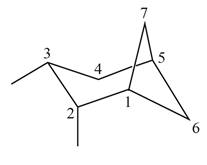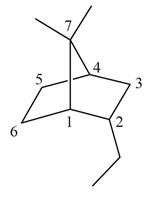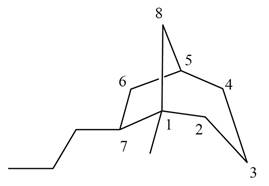
Concept explainers
Read Appendix B on naming bicyclic compounds. Then give IUPAC name for each of the following compounds.
a. 
b. 
c. 
d. 
(a)
Interpretation: The IUPAC name for the given bicyclic compound is to be stated.
Concept introduction: The root name of bicyclic compounds depends upon the number of carbon atoms present in the rings. The naming of bicyclic compounds is done as,
(1) The total number of carbon atoms in the molecule is to be counted. It represents the root name.
(2) The number of carbon atoms between the bridgeheads is to be counted and placed in square brackets in descending order.
(3) The word bicyclo is placed at the beginning of the name.
The general name such compounds is represented as
Answer to Problem 4.78P
The IUPAC name for the given bicyclic compound is
Explanation of Solution
The given bicyclic compound is shown below.

Figure 1
The given compound contains seven carbon atoms in the ring which are single bonded to each other. Therefore, the root name is heptane. In this case, there are
The IUPAC name for the given bicyclic compound is
(b)
Interpretation: The IUPAC name for the given bicyclic compound is to be stated.
Concept introduction: The root name of bicyclic compounds depends upon the number of carbon atoms present in the rings. The naming of bicyclic compounds is done as,
(1) The total number of carbon atoms in the molecule is to be counted. It represents the root name.
(2) The number of carbon atoms between the bridgeheads is to be counted and placed in square brackets in descending order.
(3) The word bicyclo is placed at the beginning of the name.
The general name such compounds is represented as
Answer to Problem 4.78P
The IUPAC name for the given bicyclic compound is
Explanation of Solution
The given bicyclic compound is shown below.

Figure 2
The given compound contains seven carbon atoms in the ring which are single bonded to each other. Therefore, the root name is heptane. In this case, there are
The IUPAC name for the given bicyclic compound is
(c)
Interpretation: The IUPAC name for the given bicyclic compound is to be stated.
Concept introduction: The root name of bicyclic compounds depends upon the number of carbon atoms present in the rings. The naming of bicyclic compounds is done as,
(1) The total number of carbon atoms in the molecule is to be counted. It represents the root name.
(2) The number of carbon atoms between the bridgeheads is to be counted and placed in square brackets in descending order.
(3) The word bicyclo is placed at the beginning of the name.
The general name such compounds is represented as
Answer to Problem 4.78P
The IUPAC name for the given bicyclic compound is
Explanation of Solution
The given bicyclic compound is shown below.

Figure 3
The given compound contains eight carbon atoms in the ring which are single bonded to each other. Therefore, the root name is octane. In this case, there are
The IUPAC name for the given bicyclic compound is
(d)
Interpretation: The IUPAC name for the given bicyclic compound is to be stated.
Concept introduction: The root name of bicyclic compounds depends upon the number of carbon atoms present in the rings. The naming of bicyclic compounds is done as,
(1) The total number of carbon atoms in the molecule is to be counted. It represents the root name.
(2) The number of carbon atoms between the bridgeheads is to be counted and placed in square brackets in descending order.
(3) The word bicyclo is placed at the beginning of the name.
The general name such compounds is represented as
Answer to Problem 4.78P
The IUPAC name for the given bicyclic compound is
Explanation of Solution
The given bicyclic compound is shown below.

Figure 4
The given compound contains seven carbon atoms in the ring which are single bonded to each other. Therefore, the root name is heptane. In this case, there are
The IUPAC name for the given bicyclic compound is
Want to see more full solutions like this?
Chapter 4 Solutions
Organic Chemistry-Package(Custom)
Additional Science Textbook Solutions
Organic Chemistry (8th Edition)
Physics of Everyday Phenomena
Campbell Biology: Concepts & Connections (9th Edition)
General, Organic, and Biological Chemistry - 4th edition
Laboratory Manual For Human Anatomy & Physiology
Biology: Concepts and Investigations
- help draw the moleculearrow_forwardHow to draw this claisen condensation reaction mechanisms/arrow_forwardWrite all of Me Possible Products For each Of the Following reactions. In each case identity all pains of enantiomers, all digsterzoners and all Meso compounds 9. 11-60 11-0-11 V-G Η Η H ~ C-11 +HB+ - 1 H b. पन्ना 171-0-11 H-C-H Н C-C=c-call +HBr Perendez ==arrow_forward
- How can i draw the mechanisms for this molecule?arrow_forwarda. Discuss and explain he difference IN Stability between the Chai and Boat Гольцу от судомехане b. For the Following Molecule draw both possible Clain conformations and explain which one is more stable and for what Reason. H. CH₂ CH₂ H "Harrow_forwarddraw out these molecules pleasearrow_forward
 Chemistry for Today: General, Organic, and Bioche...ChemistryISBN:9781305960060Author:Spencer L. Seager, Michael R. Slabaugh, Maren S. HansenPublisher:Cengage Learning
Chemistry for Today: General, Organic, and Bioche...ChemistryISBN:9781305960060Author:Spencer L. Seager, Michael R. Slabaugh, Maren S. HansenPublisher:Cengage Learning Organic Chemistry: A Guided InquiryChemistryISBN:9780618974122Author:Andrei StraumanisPublisher:Cengage Learning
Organic Chemistry: A Guided InquiryChemistryISBN:9780618974122Author:Andrei StraumanisPublisher:Cengage Learning Introductory Chemistry: An Active Learning Approa...ChemistryISBN:9781305079250Author:Mark S. Cracolice, Ed PetersPublisher:Cengage Learning
Introductory Chemistry: An Active Learning Approa...ChemistryISBN:9781305079250Author:Mark S. Cracolice, Ed PetersPublisher:Cengage Learning World of Chemistry, 3rd editionChemistryISBN:9781133109655Author:Steven S. Zumdahl, Susan L. Zumdahl, Donald J. DeCostePublisher:Brooks / Cole / Cengage Learning
World of Chemistry, 3rd editionChemistryISBN:9781133109655Author:Steven S. Zumdahl, Susan L. Zumdahl, Donald J. DeCostePublisher:Brooks / Cole / Cengage Learning




